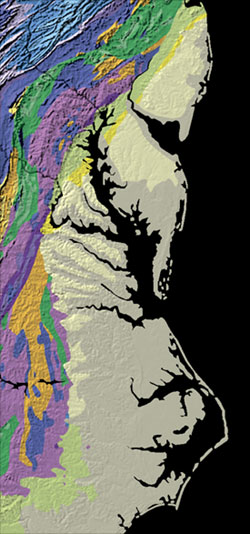Atlantic Seaboard fall line | |
|---|---|
 Map showing part of the Eastern Seaboard Fall Line where the pale-colored coastal plain meets the brightly-colored Piedmont. | |
| Location | United States |
| Formed by | New Jersey Virginia Carolinas or Georgia[1][2] |
| Dimensions | |
| • Length | 900 mi (1,400 km)[2] |
The Atlantic Seaboard Fall Line, or Fall Zone, is a 900-mile (1,400 km) escarpment where the Piedmont and Atlantic coastal plain meet in the eastern United States.[2] Much of the Atlantic Seaboard fall line passes through areas where no evidence of faulting is present.
The fall line marks the geologic boundary of hard metamorphosed terrain—the product of the Taconic orogeny—and the sandy, relatively flat alluvial plain of the upper continental shelf, formed of unconsolidated Cretaceous and Cenozoic sediments. Examples of Fall Zone features include the Potomac River's Little Falls and the rapids in Richmond, Virginia, where the James River falls across a series of rapids down to its own tidal estuary.
Before navigation improvements such as locks, the fall line was generally the head of navigation on rivers due to their rapids or waterfalls, and the necessary portage around them. Numerous cities initially formed along the fall line because of the easy river transportation to seaports, as well the availability of water power to operate mills and factories, thus bringing together river traffic and industrial labor. U.S. Route 1 and I-95 link many of the fall-line cities.
In 1808, Treasury Secretary Albert Gallatin noted the significance of the fall line as an obstacle to improved national communication and commerce between the Atlantic seaboard and the western river systems:[3]
The most prominent, though not perhaps the most insuperable obstacle in the navigation of the Atlantic rivers, consists in their lower falls, which are ascribed to a presumed continuous granite ridge, rising about one hundred and thirty feet above tide water. That ridge from New York to James River inclusively arrests the ascent of the tide; the falls of every river within that space being precisely at the head of the tide; pursuing thence southwardly a direction nearly parallel to the mountains, it recedes from the sea, leaving in each southern river an extent of good navigation between the tide and the falls. Other falls of less magnitude are found at the gaps of the Blue Ridge, through which the rivers have forced their passage...
- ^ "The Fall Line". A Tapestry of Time and Terrain: The Union of Two Maps - Geology and Topography. USGS.gov. Archived from the original on 2011-05-14. Retrieved 2010-08-12. An alternate source claims the southern endpoint is farther west because there are "waterfalls & rapids":
- "Georgia Geology". Archived from the original on 4 September 2010. Retrieved 2010-08-13.
- ^ a b c Freitag, Bob; Susan Bolton; Frank Westerlund; Julie Clark (2009). Floodplain Management: A New Approach for a New Era. Island Press. p. 77. ISBN 978-1-59726-635-2. Retrieved 17 November 2010.
- ^ [Report on] Roads and Canals, Communicated to the Senate April 4, 1808, p.729
© MMXXIII Rich X Search. We shall prevail. All rights reserved. Rich X Search
